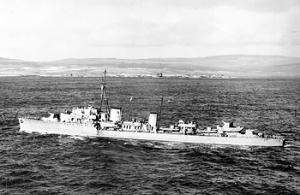HNLMS Isaac Sweers
 Isaac Sweers in October 1942 | |
| History | |
|---|---|
| Name: | Isaac Sweers |
| Namesake: | Admiral Isaac Sweers (1622–1673) |
| Builder: |
|
| Laid down: | 26 November 1938 |
| Launched: | 16 March 1940 |
| Commissioned: | 29 May 1941 |
| Fate: | Torpedoed and sunk on 13 November 1942 dead: 108 survivors: 86 |
| General characteristics | |
| Class and type: | Gerard Callenburgh-class destroyer |
| Displacement: |
|
| Length: | 107 m (351 ft 1 in) |
| Beam: | 10.6 m (34 ft 9 in) |
| Draught: | 2.8 m (9 ft 2 in) |
| Propulsion: |
|
| Speed: | 37.5 kn (69.5 km/h) |
| Range: | 3,200 nmi (5,900 km) at 15 kn (28 km/h) |
| Armament: |
|
HNLMS Isaac Sweers, (Dutch: Hr. Ms. Isaac Sweers) was a Gerard Callenburgh-class destroyer of the Royal Netherlands Navy.
Design and construction

The keel was laid on 26 November 1938. The ship was launched on 16 March 1940 and the unfinished ship was evacuated to England after the German invasion of the Netherlands. She was completed in Great Britain, with six British 4-inch dual purpose guns instead of planned five 120 mm guns. The ship was modern for her time, she was fast and had two fully stabilised 40 mm Bofors AA-guns, each with its own "Hazemeyer" fire control.
The ship's plans were saved from the Germans and elements were incorporated into Royal Navy ship designs.[1]
Operations
Isaac Sweers was part of the Allied flotilla of destroyers which torpedoed and sank the Italian cruisers Alberico da Barbiano and Alberto da Giussano on 13 December 1941, at the Battle of Cape Bon. She riddled Alberto da Giussano with gunfire at short range and launched four torpedoes against the Italian torpedo boat Cigno; all of them missed their target. She escorted the important convoy MW 8B to Malta in January 1942. During this mission the British destroyer Gurkha was torpedoed by the German submarine U-133 on 12 January 1942. Isaac Sweers towed the stricken British destroyer through a field of burning oil and saved her entire crew of 240 sailors. They were taken to Tobruk.
During Operation Torch, on 11 November 1942, along with HMS Porcupine, Isaac Sweers helped rescue 241 men from the ship Nieuw Zeeland, a Dutch troop transport that had been torpedoed by the German submarine U-380 at 35°57′N 03°58′W / 35.950°N 3.967°W - about 80 miles (130 km) east of Gibraltar, in the Mediterranean.[2] On 13 November 1942, Isaac Sweers was hit by two torpedoes from the German submarine U-431 under command of Wilhelm Dommes. She sank with the loss of 108 of her 194 crew.
Notes
- ↑ Van Soeren, p. ?
- ↑ "HMS Porcupine (G93)". uboat.net. Retrieved 26 November 2011.
References
- Bosscher, Ph. M. (1984). De Koninklijke Marine in de Tweede Wereldoorlog (in Dutch). University of Leiden. ISBN 90-6135-371-8.
- Van Kuilenburg, Het (1994). De Hr. Ms. Isaac Sweers, ontwerp, bouw en levensloop van een succesvolle torpedobootjager (in Dutch). Van Soeren. ISBN 90-6881-041-3.
- Olivier. Olie op de golven (in Dutch).